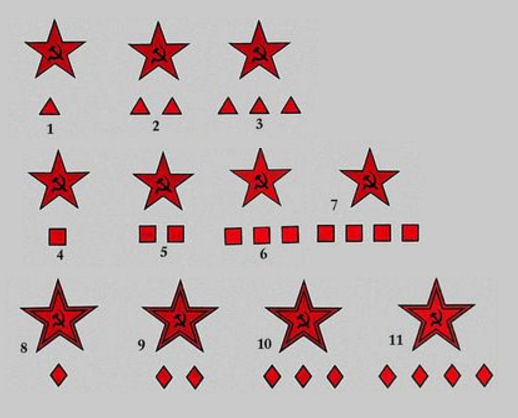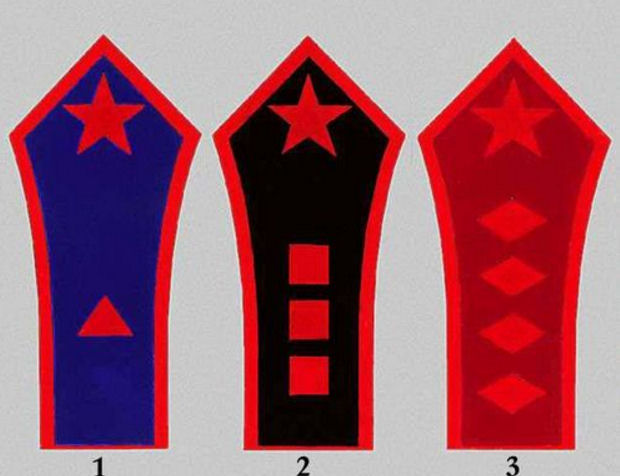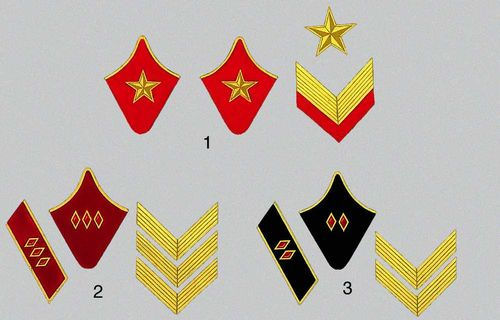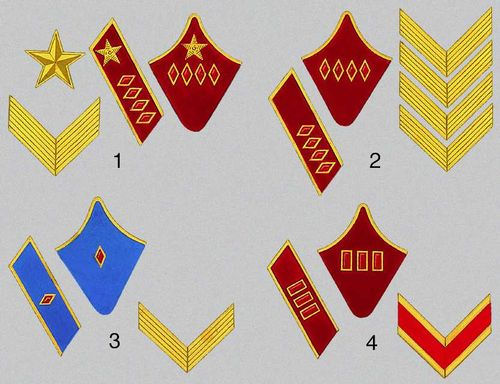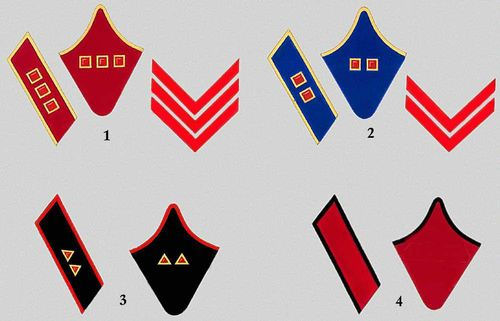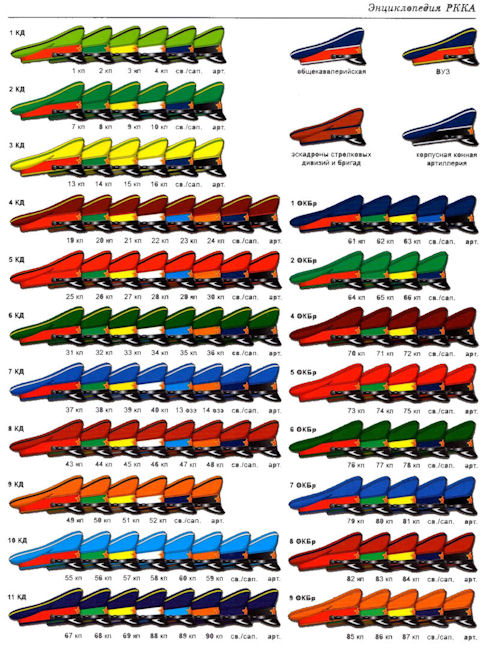1917 Ranks - Army
The proportionate large loss among officers during the early montsh of the Great War showed that conspicuous dress and mark of rank, such as highly polished boots, glass cases, field cases, insignia, uniforms, etc. made them targets for especially well directed fire. It was known, that in the Russian army 20 men in each company, composed of the best shots, are designated, in spite of any orders of the company commander, to solely direct their fire on any visible German officers. Consequently uniforms were changed and in both the Russian and German armies the officers discarded the useless saber and armed themselves with the infantry rifle.
On the streets the brilliant uniforms of the variegated regiments of the Russian army gave place to the simple khaki tunics, with little but the insignia of rank to distinguish the general from the youngest subaltern.
The color of the Russian army uniform was a greenish yellow, of a much lighter shade than that worn by most armies using the khaki uniform. Field overcoats are made of a grayish brown material extremely thick and heavy. Coats and trousers are tight-fitting and high black boots are worn by officers and men of all branches of the service. Unlike the Navy, the insignia of rank had not been changed since the revolution, the old shoulder marks being worn. All medals and decorations are worn on the service uniforms on all occasions.
The Bolshevik government abolished the Table of Ranks in decrees of 23 November and 29 December 1917. Upon assuming power, the Bolsheviks introduced the election of officers and abolished all rank, insignia, decorations, and salutes. The traditional military designation “commander” became a function of job rather than rank. Krylenko issued a general order by which the rank of officer in the Russian Army was abolished; the different companies, batteries, battalions, regiments, brigades, divisions, army Corps and armies were to select their own leaders or commanders, but the leaders were to Wear no special insignia of their command. The order was caried out. The majority of soldiers paid no attention to the order, but the worst elements in each company held a meeting and selected one of themselves for the commanding officer of the company. The former officers were urged to do kitchen police and were taught fra"rnity and equality by blows, kicks, bayonets and in the end by powder and shot. Thus the radical idea of equality was realized in the Russian Army, as thousands of officers were tortured and killed merely because they were better educated than the soldiers.
The early Bolshevik leaders were particularly anxious to avoid a professional army detached from the Communist Party and the people, which might try to be an independent power in the political life of the country. This was one of the reasons for the creation of the Institute of Political Commissars during the civil war in Russia, according to which every professional officer serving in the Red Army was controlled by an experienced commissar, without whose countersignature no order was valid.
The first signs of differences in the Red Army were introduced in January 1919. Made from red cloth, they were sewn on the left sleeve of the tunic and greatcoat over the cuff. Patches consisted of a five-pointed star, located under the insignia - triangles, cubes, diamonds. They were commanders of various levels.
In 1922, the geometric shape insignia were mounted on the arm-valves are very similar to the shoulder straps. They were made of different colors, each of which corresponds to a certain kind of troops. One more novelty was introduced in 1924: the triangles, cubes, diamonds moved to the buttonhole. They are supplemented by another geometric figure - the tie, which is a rectangle in shape. They designated representatives of the senior command structure: one - the captain, the two - major, three - Colonel.
When the civil war ended, strenuous efforts were made by the new government to ensure that the Red Army was thoroughly integrated into the Communist political system. The commissar system was confirmed at the 13th Party Congress in 1924, recruitment was severely restricted to the sons of workers or peasants, and all personal ranks were abolished. Commanders and soldiers ate in the same mess and wore the same uniform which had detachable badges indicating the responsibilities of those who held command or staff posts.
With the creation of the Red Army to determine the affiliation to its composition in 1918 was introduced by Red Army lapel badge in the form of a wreath of laurel and oak branches, on top of which was placed a five-pointed star , covered with red enamel . In the center of the star was an emblem - the plough and the hammer. In July 1918 set icon - badge for head-dress Red Army soldiers and commanders ( five-pointed red star with the emblem of the plow and the hammer in the center ). On the collars of their overcoats was sewn buttonholes color on the old forces. For the first time in the Red Army entered in January 1919 in the form of arm- signs of scarlet cloth , which are sewn on the left sleeve tunic and overcoat over the cuff . Patches consisted of a five-pointed star of red color.
The Navy command structure placed on both sleeves above the cuff in the form of horizontal stripes of gilded braid . The distinction between the categories of team composition was determined by the number of stripes and their width.
Red Army commanders after the abolition of the czarist ranks and titles differed in position. If an offiver got a new position, his clothing was the new insignia. Once appointed a commander of a brigade - he could, without asking, put on diamond buttonholes. A Division had two diamonds, etc., etc. And the word "soldier" was not used. The rank and file was then called "fighter", "Red Army". Measures have raised the morale of the Red Army. It was very important in the construction and improvement of the military organization.
Since the introduction in January 1922 for the personal composition of the Red Army a new unified form of clothing. They began to be placed on a special valve, which is sewn on the left sleeve of his greatcoat and tunic on the middle sleeve of the cloth, the color on the old troops with scarlet piping. All sorts of troops , offices and agencies of the military departments were introduced emblem on the lapels of their overcoats and gimnast?rok . On Krasnoarmeysky icon instead of the plow and the hammer began to portray the sickle and hammer. From 1924 they began to be made from red copper, attached them to their buttonholes. The senior command structure in March 1925 , instead of squares entered rectangles.
Patches mark differences in the command structure of the Red Army , entered 16 January 1919: 1 . Separated commander . 2 . Assistant commander of the platoon . 3 . Sergeant . 4 . The commander of the platoon . 5 . The commander of the company . 6 . The commander of the battalion . 7 . The commander of the regiment . 8 . The commander of the brigade . 9 . Head of Division . 10 . The commander of the army . 11 . The commander of the front
Patches marks differences command structure of the Red Army , entered 31 January 1922 ( color fields valve - on the nature of the troops ) : 1 . The commander of the department ( cavalry ). 2 . The commander of the battalion ( division ) ( artillery ). 3 . The commander of the front .
Insignia, entered December 3, 1935 (tabs and fields Patches of color buttonholes and edge - the combat arm.): 1. Marshal. 2. The Corps Commander (infantry). 3. Divisional Commander (armored troops).
Signs of differences , entered 3 December 1935 ( tabs and arm- signs . The color fields buttonholes and edge - on old troops ) : 1 . Commander 1 - st rank . 2 . Commander 2 - the second rank . 3 . Brigade Commander ( Air Force ). 4 . Col. ( Infantry ).
Insignia, , entered 3 December 1935 ( tabs and arm- signs . The color fields buttonholes and edge - on old troops ) : 1 . Major ( Artillery ). 2 . Captain ( Air Force ). 3 . Sergeant ( infantry ). 4 . Junior platoon commander ( the host . And the administrative structure ).
Insignia, entered December 3, 1935 (tabs and fields Patches of color buttonholes and edge - : 1 . Senior Lieutenant ( Infantry ). 2. Lieutenant ( Cavalry ). 3 . Separated commander ( artillery ). 4 . Red Army ( infantry ).
During the 1920s, Soviet cavalry caps were truly kaleidoscopic; with each regiment and brigade/divisional headquarters and artillery formations having their own unique combination of crown, band and piping colors. Each cavalry division [KD] had a unique crown coloer, with each subordinate regiment featuring a band which was common to each squadron of that number. Colors were unified in 1929, with all cavalry adopting the combination shown here: a khaki crown with "cornflower" blue band and black piping. The cavalry continued to wear this cap for field, service and dress/parade wear until cavalry units were disbanded around 1950.
Traditional military ranks, which the Bolshevik leadership had abolished in December 1917, were not reestablished until 1935, and then only partially. The Soviets finally adopted a unified military rank structure in 1945.
|
NEWSLETTER
|
| Join the GlobalSecurity.org mailing list |
|
|
|



